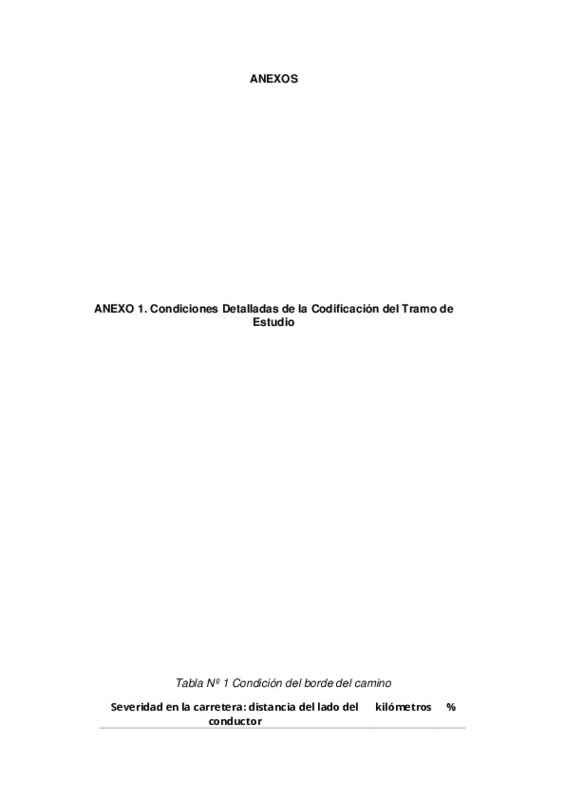|
Resumen:
|
[ES] El Cusco - Perú presenta un incremento poblacional en su diversa topografía, y con el fin de interconectar y articular todas sus localidades, las entidades encargadas ejecutan vías de dos carriles en zonas de montaña, ...[+]
[ES] El Cusco - Perú presenta un incremento poblacional en su diversa topografía, y con el fin de interconectar y articular todas sus localidades, las entidades encargadas ejecutan vías de dos carriles en zonas de montaña, sin embargo, deja de lado algo importante y es la seguridad de sus vías. A todo esto, de acuerdo al último reporte de la (Dirección de Seguridad Vial, 2022), las personas fallecidas en el 2021 a nivel nacional, sufrió un incremento alarmante de un 40.4% respecto al año anterior y como parte de esa estadística la ciudad del Cusco presento un 78.0 % de incidentes solo en carreteras del tipo montañoso. Es así frente a esta situación, el presente Trabajo de Fin de Máster, tuvo como objetivo evaluar la Seguridad Vial de la Carretera EMP. PE 3S - Pumamarca - EMP. CU 1105, debido a que este, es una red vial importante de la provincia del Cusco y principalmente es un desvío de tránsito alterno a sus provincias con atractivos turísticos. Para poder alcanzar este objetivo se realizó previamente la recolección de datos de campo como: el conteo vehicular, levantamiento topográfico y la restitución de la geometría con la finalidad de obtener las condiciones geométricas de la vía a detalle. Para los procedimientos de la evaluación se adoptaron dos herramientas fundamentales, como primero los propuestos por Pérez Zuriaga y Llopis Castelló para la estimación de velocidades de operación e inercial. Para el caso de la consistencia y estimación del número de incidentes con víctimas en carretera, por el autor antes ultimo mencionado, así mismo se midió las velocidades en campo con el fin de construir un perfil de velocidades y realizar un versus entre estos. Determinado estos resultados se procedió a la evaluación, y se obtuvo de este análisis 12 puntos inconsistentes y 9.65 incidentes con víctimas en la carretera. La otra herramienta, utilizada fue el software iRAP - VIDA (International Road Assessment Programme), del cual previo al resultado se procesó los atributos de la carretera cada 100 metros, así encontrándose de este, que más del 50% del tramo presenta calificación de estrellas entre "1 y 2". Ahora referente a la estimación de víctimas en la carretera mediante esta herramienta se obtuvo 50.1 incidentes. Finalmente, de la evaluación realizada por ambas herramientas, se planteó un plan de inversión para vías más seguras, proponiéndose 11 contramedidas que en conjunto tienen un costo de inversión de S/. 5,893,648.00 soles peruanos destinados a salvar la vida de 457 personas, obteniendo así una relación costo - beneficio de 21.33, el cual se encuentra dentro del umbral de la relación costo beneficio del iRAP.
[-]
[EN] Cusco - Peru presents a population increase in its diverse topography, and in order to interconnect and articulate all its localities, the entities in charge execute two-lane roads in mountain areas, however, it leaves ...[+]
[EN] Cusco - Peru presents a population increase in its diverse topography, and in order to interconnect and articulate all its localities, the entities in charge execute two-lane roads in mountain areas, however, it leaves aside something important and that is security. of its tracks. To all this, according to the latest report from the (Road Safety Directorate, 2022), the number of people who died in 2021 at the national level suffered an alarming increase of 40.4% compared to the previous year and as part of that statistic, the city Cusco had 78.0% of incidents only on mountainous roads. Thus, in view of this situation, the present Master's Thesis aimed to evaluate the Road Safety of the EMP Highway. PE 3S - Pumamarca - EMP. CU 1105, because this is an important road network in the province of Cusco and is mainly an alternative traffic detour to its provinces with tourist attractions. In order to achieve this objective, field data was previously collected, such as: vehicle counting, topographic survey and geometry restitution in order to obtain the geometric conditions of the road in detail. For the evaluation procedures, two fundamental tools were adopted, first those proposed by Pérez Zuriaga and Llopis Castelló for the estimation of operating and inertial speeds. In the case of consistency and estimation of the number of incidents with victims on the road, by the last mentioned author, the speeds in the field were also measured in order to build a speed profile and perform a versus between them. Once these results were determined, the evaluation was carried out, and from this analysis 12 inconsistent points and 9.65 incidents with victims on the road were obtained. The other tool used was the iRAP - VIDA software (International Road Assessment Programme), from which, prior to the result, the attributes of the road were processed every 100 meters, thus finding that more than 50% of the section has a star rating between "1 and 2". Now regarding the estimation of victims on the road using this tool, 50.1 incidents were obtained. Finally, from the evaluation carried out by both tools, an investment plan for safer roads was proposed, proposing 11 countermeasures that together have an investment cost of S/. 5,893,648.00 Peruvian soles destined to save the lives of 457 people, thus obtaining a cost-benefit ratio of 21.33, which is within the threshold of the cost-benefit ratio of the iRAP.
[-]
|








